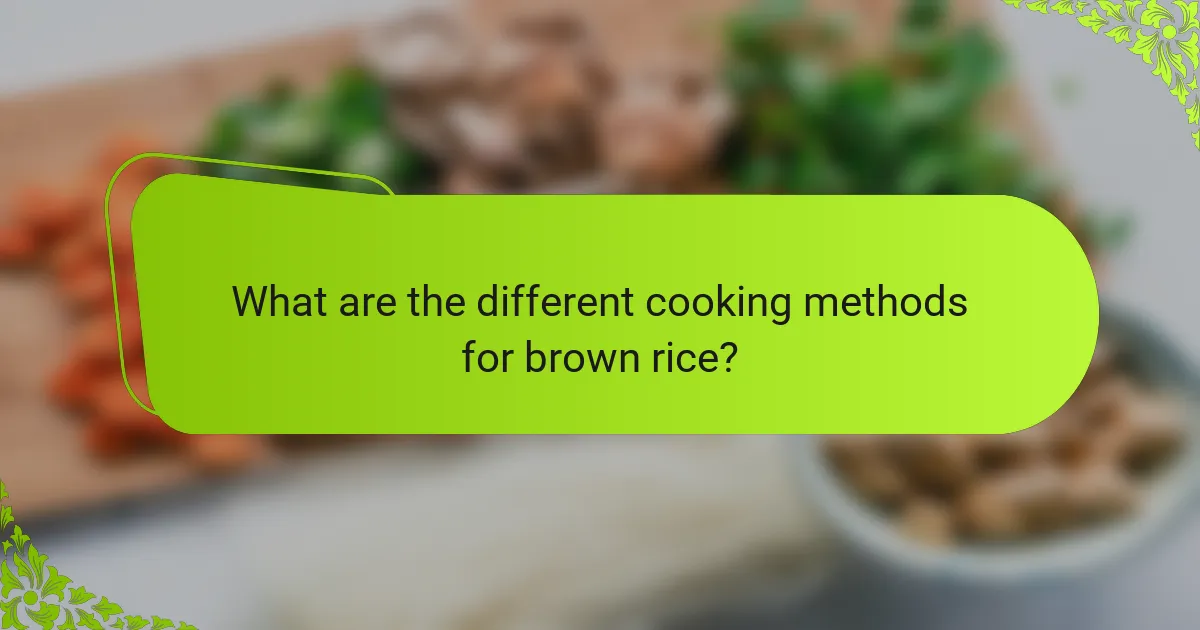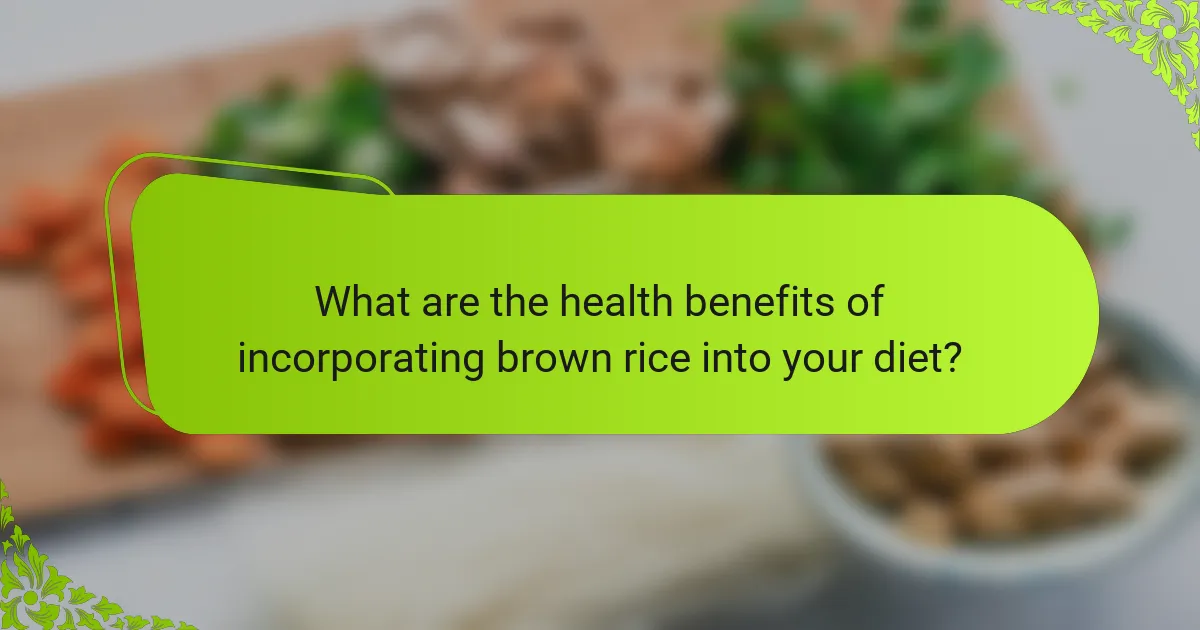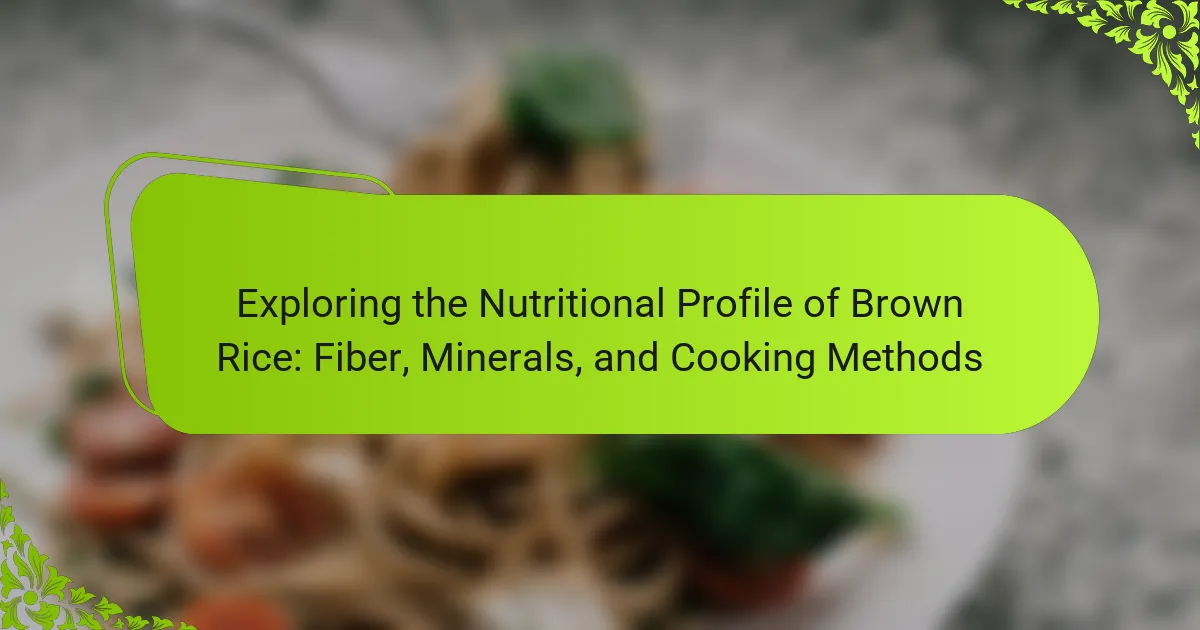
What is the nutritional profile of brown rice?
Brown rice is a whole grain that provides essential nutrients. It contains approximately 218 calories per cooked cup. Brown rice is rich in carbohydrates, with about 45 grams per serving. It has around 5 grams of protein and less than 2 grams of fat.
The fiber content is significant, offering about 3.5 grams per cup. This fiber aids in digestion and promotes satiety. Brown rice is also a source of several minerals. It contains magnesium, phosphorus, and manganese.
Additionally, it provides small amounts of iron and zinc. The nutritional profile makes brown rice a healthy choice for various diets. It is often recommended for its whole grain benefits compared to white rice.
How does brown rice compare to white rice nutritionally?
Brown rice is nutritionally superior to white rice. It contains more fiber, which aids digestion. A 100-gram serving of brown rice has about 2.8 grams of fiber. In contrast, white rice has only 0.4 grams of fiber per 100 grams. Brown rice also retains more vitamins and minerals. It is rich in magnesium, with approximately 43 mg per 100 grams. White rice, however, contains only about 12 mg of magnesium in the same serving size. Additionally, brown rice has higher levels of antioxidants. These nutritional benefits contribute to better overall health.
What are the key nutrients found in brown rice?
Brown rice is rich in several key nutrients. It contains high levels of dietary fiber, which aids in digestion. Brown rice also provides essential minerals such as magnesium, phosphorus, and manganese. Additionally, it contains B vitamins, including niacin and thiamine. The presence of antioxidants in brown rice contributes to its health benefits. Each serving of brown rice offers around 3.5 grams of fiber and significant amounts of these minerals. This nutritional profile supports overall health and wellness.
How does the fiber content in brown rice benefit health?
The fiber content in brown rice benefits health by promoting digestive health and aiding in weight management. Brown rice contains approximately 3.5 grams of fiber per cooked cup. This fiber helps regulate bowel movements and prevent constipation. It also contributes to a feeling of fullness, which can reduce overall calorie intake. Studies show that a high-fiber diet can lower the risk of chronic diseases. For instance, research published in the Journal of Nutrition indicates that fiber intake is linked to a reduced risk of heart disease. The fiber in brown rice also helps manage blood sugar levels, making it beneficial for individuals with diabetes.
Why is fiber an important component of brown rice?
Fiber is an important component of brown rice because it promotes digestive health. Brown rice contains about 3.5 grams of fiber per 100 grams. This fiber aids in regular bowel movements and prevents constipation. Additionally, fiber helps regulate blood sugar levels. It slows down the absorption of sugar, which can reduce the risk of type 2 diabetes. Furthermore, fiber contributes to satiety. This means it helps individuals feel full longer, which can assist in weight management. Overall, the fiber content in brown rice enhances its nutritional value and health benefits.
What types of fiber are present in brown rice?
Brown rice contains both soluble and insoluble fiber. Soluble fiber helps regulate blood sugar levels and lowers cholesterol. Insoluble fiber aids in digestion and promotes regular bowel movements. The presence of these fibers contributes to the overall health benefits of brown rice. Studies indicate that a diet high in fiber can reduce the risk of chronic diseases.
How does dietary fiber from brown rice aid digestion?
Dietary fiber from brown rice aids digestion by promoting regular bowel movements. The insoluble fiber in brown rice adds bulk to stool. This bulk helps food pass through the digestive tract more easily. Additionally, fiber slows down digestion, which can enhance nutrient absorption. Studies show that a high-fiber diet can reduce the risk of constipation. Brown rice contains about 3.5 grams of fiber per cooked cup. This amount supports healthy gut function and overall digestive health.
What minerals are abundant in brown rice?
Brown rice is abundant in several essential minerals. Key minerals include magnesium, phosphorus, and manganese. Magnesium contributes to muscle and nerve function. Phosphorus is vital for bone health and energy production. Manganese plays a role in metabolism and antioxidant defense. According to the USDA, one cup of cooked brown rice contains approximately 84 mg of magnesium, 150 mg of phosphorus, and 1.1 mg of manganese. These values confirm the mineral richness of brown rice.
Which minerals contribute to the health benefits of brown rice?
Brown rice contains several essential minerals that contribute to its health benefits. Key minerals include magnesium, phosphorus, and manganese. Magnesium supports muscle and nerve function, and it plays a role in energy production. Phosphorus is important for bone health and helps in the formation of DNA. Manganese contributes to metabolism and antioxidant defense. The presence of these minerals enhances the overall nutritional value of brown rice, making it a beneficial food choice.
How does the mineral content in brown rice support overall health?
The mineral content in brown rice supports overall health by providing essential nutrients. Minerals such as magnesium, phosphorus, and potassium contribute to various bodily functions. Magnesium aids in muscle function and energy production. Phosphorus is vital for bone health and cellular repair. Potassium helps regulate blood pressure and fluid balance. Brown rice also contains iron, which is crucial for oxygen transport in the blood. A diet rich in these minerals can reduce the risk of chronic diseases. Studies show that whole grains like brown rice are linked to lower heart disease risk. The presence of these minerals enhances overall well-being and supports metabolic processes.

What are the different cooking methods for brown rice?
The different cooking methods for brown rice include boiling, steaming, and baking. Boiling involves simmering rice in water until it absorbs the liquid. Steaming cooks rice using steam, which retains more nutrients. Baking entails placing rice in an oven with water, allowing even cooking. Each method affects texture and flavor. Boiling typically results in softer rice. Steaming produces firmer grains. Baking can create a unique, nutty flavor. These methods are widely used and can be adapted based on preference.
How can brown rice be cooked effectively?
To cook brown rice effectively, rinse it thoroughly under cold water to remove excess starch. Use a ratio of 2 cups of water for every 1 cup of brown rice. Bring the water to a boil in a pot, then add the rinsed rice. Reduce the heat to low and cover the pot with a lid. Simmer for 45 to 50 minutes until the rice absorbs the water. After cooking, let the rice sit covered for 10 minutes to steam. Fluff the rice with a fork before serving. This method ensures the rice is tender and fully cooked.
What are the recommended water-to-rice ratios for cooking brown rice?
The recommended water-to-rice ratio for cooking brown rice is 2:1. This means for every cup of brown rice, two cups of water should be used. This ratio is essential for achieving the desired texture and doneness of the rice. Cooking brown rice typically requires more water than white rice due to its outer bran layer. The additional water helps to soften the bran and ensure even cooking. Following this ratio can result in fluffy and well-cooked brown rice.
Which cooking methods preserve the nutritional value of brown rice?
Steaming and boiling are cooking methods that preserve the nutritional value of brown rice. Steaming retains more nutrients compared to boiling. Boiling can cause some vitamins and minerals to leach into the water. Using a minimal amount of water for boiling can help reduce nutrient loss. Cooking brown rice with the absorption method also helps maintain its nutrients. This method allows the rice to absorb all the water, minimizing nutrient loss. Cooking times should be monitored to avoid overcooking, which can degrade nutrients. Overall, steaming and absorption cooking are optimal for preserving the nutritional integrity of brown rice.
What are some common mistakes when cooking brown rice?
Common mistakes when cooking brown rice include not rinsing the rice before cooking. Rinsing removes excess starch, which can make the rice gummy. Another mistake is using insufficient water. Brown rice typically requires a higher water-to-rice ratio than white rice, usually about 2.5 to 1. Cooking for too short a time is also common. Brown rice needs about 40-50 minutes to cook thoroughly. Not letting the rice rest after cooking is another error. Allowing it to sit for 10 minutes helps achieve better texture. Lastly, not adjusting cooking time based on the rice’s age can lead to inconsistencies. Older brown rice may require longer cooking times.
How can overcooking affect the texture and nutrients of brown rice?
Overcooking brown rice significantly alters its texture and nutrient content. The texture becomes mushy and sticky due to excessive water absorption. This change occurs because the starches in brown rice gelatinize and break down when exposed to prolonged heat. Nutritionally, overcooking can lead to the loss of B vitamins and minerals. Research indicates that prolonged cooking times can reduce the availability of nutrients like magnesium and zinc. Overcooked brown rice may also have a higher glycemic index, impacting blood sugar levels. Therefore, cooking brown rice for the appropriate duration is essential for maintaining its desirable texture and nutritional benefits.
What tips can help achieve perfectly cooked brown rice?
To achieve perfectly cooked brown rice, rinse the rice thoroughly before cooking. Rinsing removes excess starch, preventing stickiness. Use a water-to-rice ratio of 2:1 for optimal texture. This ratio ensures the rice absorbs enough moisture. Bring the water to a boil, then reduce to a simmer. Cover the pot to trap steam, which aids in cooking. Cook for 40-50 minutes until the rice is tender. Let the rice sit covered for 10 minutes after cooking. This resting period allows for steam distribution, enhancing texture. Fluff the rice with a fork before serving to separate grains.

What are the health benefits of incorporating brown rice into your diet?
Incorporating brown rice into your diet offers multiple health benefits. Brown rice is a whole grain that retains its bran and germ, providing essential nutrients. It is rich in dietary fiber, which aids in digestion and helps maintain a healthy weight. Studies show that a high-fiber diet can reduce the risk of chronic diseases, including heart disease and type 2 diabetes.
Additionally, brown rice is a good source of magnesium, which supports muscle and nerve function. It contains antioxidants that may help combat oxidative stress in the body. Consuming whole grains like brown rice has been linked to lower cholesterol levels. Research indicates that whole grain consumption is associated with a reduced risk of cardiovascular disease. Overall, brown rice contributes to a balanced diet and promotes overall health.
How does brown rice contribute to a balanced diet?
Brown rice contributes to a balanced diet by providing essential nutrients and fiber. It is a whole grain, meaning it retains the bran and germ layers. This structure allows brown rice to offer more fiber than white rice. Fiber aids in digestion and helps maintain a healthy weight.
Brown rice is also rich in minerals like magnesium, phosphorus, and selenium. Magnesium supports muscle and nerve function, while phosphorus is crucial for bone health. Selenium acts as an antioxidant, protecting cells from damage.
Additionally, brown rice has a lower glycemic index compared to white rice. This means it can help regulate blood sugar levels. Overall, incorporating brown rice into meals enhances nutritional value and supports overall health.
What role does brown rice play in weight management?
Brown rice aids in weight management by providing high fiber content and essential nutrients. The fiber in brown rice promotes satiety, which can reduce overall calorie intake. One cup of cooked brown rice contains about 3.5 grams of fiber. This fiber helps regulate digestion and maintains stable blood sugar levels. Additionally, brown rice has a lower glycemic index compared to white rice. This means it contributes to a slower release of glucose into the bloodstream. Consuming brown rice instead of refined grains has been associated with lower body weight in various studies. For instance, a study published in the Journal of Nutrition found that whole grains, including brown rice, were linked to lower body fat percentages. Thus, incorporating brown rice into a balanced diet can support effective weight management.
How can brown rice help in preventing chronic diseases?
Brown rice can help in preventing chronic diseases due to its high fiber content and nutrient density. The fiber in brown rice aids in digestion and helps maintain healthy blood sugar levels. This can reduce the risk of type 2 diabetes. Additionally, brown rice contains antioxidants that may lower inflammation. Studies have shown that whole grains, including brown rice, are associated with a lower risk of heart disease. The magnesium in brown rice supports cardiovascular health by regulating blood pressure. Furthermore, the presence of essential minerals can enhance overall health, contributing to disease prevention.
What are some easy recipes that feature brown rice?
Brown rice can be used in various easy recipes. One simple dish is brown rice stir-fry. This involves sautéing vegetables like bell peppers and carrots, then adding cooked brown rice and soy sauce. Another recipe is brown rice salad. Combine cooked brown rice with chopped cucumbers, tomatoes, and a lemon vinaigrette. A third option is brown rice and beans. Mix cooked brown rice with black beans, corn, and spices for a nutritious meal. Each of these recipes highlights the versatility of brown rice while being easy to prepare.
How can brown rice be incorporated into everyday meals?
Brown rice can be incorporated into everyday meals in various ways. It serves as a nutritious base for stir-fries. Combine brown rice with vegetables and protein for a balanced dish. Brown rice can also be added to soups for extra fiber and texture. Use it in salads for a hearty, filling option. It can replace white rice in any recipe for added nutrients. Brown rice works well in grain bowls topped with proteins and sauces. Additionally, it can be used in casseroles for a wholesome meal. Cooking brown rice takes longer than white rice, typically 40-50 minutes, but its health benefits justify the time.
What are some creative ways to use brown rice in cooking?
Brown rice can be used creatively in various dishes. It serves as a base for stir-fries, adding texture and nutrition. Brown rice can also be incorporated into salads, providing a hearty element. It works well in soups, thickening the broth and enhancing flavor. Brown rice can be used to make risottos, offering a nutty taste. It can be blended into veggie burgers for added fiber. Brown rice can be used in breakfast bowls, topped with fruits and nuts. Lastly, it can be used as a filling for stuffed peppers, combining flavors and nutrients.
What are the best practices for storing brown rice?
Store brown rice in an airtight container to maintain its freshness. This prevents moisture and pests from affecting the rice. Keep the container in a cool, dark place, as light and heat can degrade its quality. For long-term storage, consider refrigerating or freezing brown rice. These methods can extend its shelf life significantly. Brown rice typically lasts about six months at room temperature but can last up to a year when refrigerated. Proper storage is essential to preserve its nutritional value, including fiber and minerals.
How does proper storage affect the shelf life of brown rice?
Proper storage significantly extends the shelf life of brown rice. When stored in a cool, dry place, brown rice can last up to six months. Using airtight containers helps prevent moisture and pests from damaging the rice. Exposure to air can lead to oxidation, which decreases quality and shelf life. Storing brown rice in the refrigerator or freezer can further prolong its freshness. In these environments, it can last up to a year or more. Studies show that proper storage conditions help maintain the nutritional value of brown rice. Therefore, effective storage practices are essential for maximizing its shelf life and quality.
What are the signs that brown rice has gone bad?
Brown rice has gone bad if it shows signs of spoilage such as an off smell, discoloration, or the presence of mold. An off smell indicates that the rice has started to decompose. Discoloration, such as yellow or dark spots, can signal that the rice is no longer fresh. Mold growth is a clear sign of spoilage and makes the rice unsafe to consume. Additionally, if the rice feels excessively hard or has an unusual texture, it may be spoiled. Always check for these signs before using brown rice to ensure safety and quality.
The main entity of the article is brown rice, a whole grain known for its nutritional benefits. The article provides a detailed overview of brown rice’s nutritional profile, highlighting its rich fiber content, essential minerals such as magnesium and phosphorus, and the advantages of incorporating it into a balanced diet. It also compares brown rice to white rice, emphasizing its superior fiber and nutrient retention. Additionally, various cooking methods, storage tips, and health benefits associated with brown rice are discussed, making it a valuable addition to dietary practices aimed at improving overall health and wellness.




